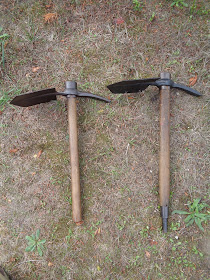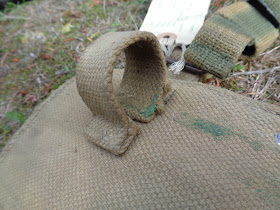I bought this entire set from a seller down in Southern California. He said he picked it up at a flea market, and knew nothing about its history. So, it has been a bit of a fun research project to peel back all the layers of history on this set. It's not often I have something with this many diverse clues written in the details!
The entrenching tool portion of the set is a British, "Implement Entrenching Pattern 1937, Helve Mk II". The metal head is dated 1942, with an unreadable maker's mark.
UPDATE 7/19/2021: One of my readers identified the maker's mark. It was made by CHILLINGTON. I did some checking and the stamp matches other tool heads made by Chillington. A big thank you to Øyvind Amundsen!
On the back side of the entrenching tool blade, there is a white import marking stamped "MADE IN ENGLAND". I believe that during the 1980's and part of the 1990's, imported surplus items were required to have a country of manufacture stamped on them. For now I'll leave the stamp in place as part of it's history, but these paint stamps are easy to remove if one wants.
The wooden handle, or helve, is the second pattern, officially called the "Helve Mk II". The Mk. II entrenching tool helves were designed to mount the No.4 Mk. II spike bayonets. This wooden handle was first made in 1944, just before the D-Day invasion of France. I believe that the thought was that the troops would be encountering numerous mine fields in France, and having a proper tool to probe for mines would be helpful.
The old style Mk I, plain wood handle, was modified by adding a metal end cap that replicated the barrel end of the Lee-Enfield Mk I service rifle. This specialized end cap allowed the No. 4 Mk II spike bayonet to be attached. The handle, with the attached bayonet, became a new tool used to probe for mines when encountering a minefield. The end cap on this handle is marked 1944, with the British Broad Arrow.
You can read about the first version of these entrenching tools with the plain handle in my previous post, here:
https://sharky-fourbees.blogspot.com/2019/09/british-entrenching-tool-ww2-implement.html
For a more complete, and detailed history of these tools, you can check out this excellent website:
http://www.karkeeweb.com/patterns/1937/1937_entrenching_tools_tools.html
Just above the spike end cap, there is a hole that has been drilled through the handle. From what I understand, the entrenching tool handles, both the first and second models, were sometimes used as a "police baton, or night stick", by soldiers on security duty. When handles were used in this manner, a hole was drilled at the small end, to attach a loop of cord or leather thong. So it would seem that this handle may have seen some "patrol duty", as well as field use!
One of the previous owners also marked this handle with his initials. This is something that I find very appealing when I find these old tools. I love having that "personal touch", and proof that the tool really did belong to someone.
The set came with a very nice, No. 4 Mk. II spike bayonet and frog. The bayonet was made by the US firearms company, Savage. Savage made bayonets, and later, rifles for the British, under the "Lend-Lease" program. The frog is the early style that could be used with the older, long bladed bayonets, or with the spike bayonets. it is dated 1943. The date stamping and makers marks are a bit blurred, but the date is clearly visible.
This brings us to the canvas carrier. This is one of the harder to find items when it comes to these old British entrenching tool sets. There are usually pile of tools, but only a few carriers floating around to go with them. When I discovered this set, and saw that it had a carrier to go with it, I was thrilled!
This carrier is date marked with what I believe is 1941. The last number is blurred from excessive ink, but it looks like it is a number one. That would make this one of the first issue, WW2 carriers. The maker's name is printed next to it (not sure of the exact spelling on the name), as well as the British Broad Arrow acceptance mark.
Here is the part where things get "interesting" with this carrier..........
There is a tag attached to the carrier that has some very interesting information on it. The tag is a "decommissioning tag" that was attached when the carrier was pulled out of service and placed in reserve.
The tag is from the British, Royal Air Force, RAF, and is marked with the unit: RAF Station Flexstowe. This has to be the "crown jewel" of the entire ensemble!
There is no date on the tag, but the tag has a blank spot for the year that is partially pre-printed, 1962__. Station Flexstowe was shut down in June, 1962.
I am going to guess that this tag was placed on this carrier when the base was shut down, and the gear was "moth balled" and shipped out to warehouses. This is the only tag like this that I have encountered, and the fact that it carries so much information is amazing!
RAF Station Flexstowe was probably one of the most famous and interesting, of all the England bases. This base has a VERY rich history, beginning back in WW1. It was responsible for the design and construction of the early seaplanes, and as the main base for the coastal torpedo patrol boats that attacked the Germans in the English Channel during WW2. The base also hosted a number of famous air squadrons through the years. Currently there is a British Air Cadet unit based there (basically a boy scout group centered on Air Service). You can read more about the base and the various units here:
http://356atc.co.uk/web/index.php/squadron-information/history/raf-felixstowe
The interesting details of this carrier do not stop there. The bag has a "green triangle" stenciled onto it, with some green paint smudges that overlap the carrier and strap end. This would indicate that the strap was on the carrier when the triangle was stenciled. Why is this interesting? Well, these old carriers were not meant to be carried with a shoulder strap. They were meant to be carried, attached to the belt. So. the shoulder strap set-up was something unique.
The "green triangle" is something that I have not encountered before, but it appears to have been on the carrier for quite some time, so I am guessing that it has some official significance. The triangle symbol was adopted by many countries after WW2 as a Civil Defense emblem, in one form or another. So I am guessing that after this carrier completed its service with the RAF, it found its way to a defense unit. If anyone recognizes it, by all means let me know.
So, we will assume that the shoulder strap was attached at a civil defense unit so the entrenching tool could be carried as a stand alone piece of equipment. That makes sense. What doesn't make sense is the strap itself.
The shoulder strap is not British. It is constructed out of "British type fabric", but is not a British design. The tension-buckles are not British. They appear to be of the US style. The only country that I know of that used, and issued, web gear that was a cross between the British and US styles was Israel.
A bit of research turned up a match for the shoulder strap. It appears that this strap and shoulder pad, are Israeli. The strap is an IDF (Israeli Defence Force), Uzi submachinegun sling! This is the style slings that were used in the 1960's and 1970's in Israel.
So it would appear that this carrier and entrenching tool ended up being sent to Israel after decommissioning. It's my guess that it was possibly set up for a unit in the Israeli Civil Defence, but never issued out, due to the fact that the RAF tag was still attached.
Of course, we will never know the exact details of this grouping's history, but from what we can weave from the unique details, I think we have hit pretty close to its actual history!
Here is a quick comparison of the Type 1 and Type II style handles (Helves), side-by-side. The same metal head was used on both, so they are interchangeable. Type I on the left, and Type II on the right.
So, after that long-winded narrative, let's take a closer look at this British - Israeli - US, grouping (British tool, Israeli strap, and US made bayonet):




































































